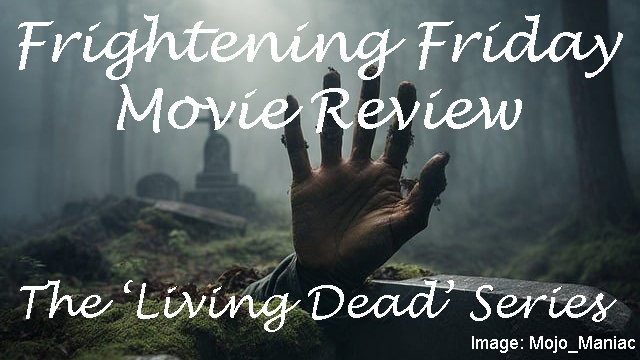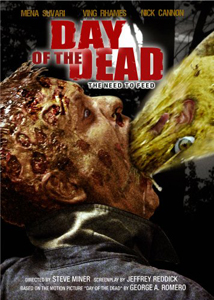“Day of the Dead” (2008) completes an unofficial remake trilogy (each of the three remakes is by a different creative team) of George Romero’s original “Living Dead” trilogy with by far the worst and least-connected entry.
An underground bunker is 90 percent of the 1985 film’s setting, and 5 percent of this film’s; a somewhat intelligent zombie features in both; and both have a military captain named Rhodes. That’s about it, as veteran blue-collar director Steve Miner (“Friday the 13th” parts two and three) gives his contribution to the “28 Days Later” Fast Zombie era.
As with 2004’s “Dawn of the Dead” but even more so, “Day of the Dead” is the action-film equivalent of butt-rock music, with jittery editing of the orgies of violence. The script by Jeffrey Reddick (the “Final Destination” series) goes even further into making almost everyone unlikeable.

“Day of the Dead” (2008)
Director: Steve Miner
Writers: Jeffrey Reddick (screenplay), George A. Romero (1985 screenplay)
Stars: Mena Suvari, Nick Cannon, Michael Welch
Even the good people – like military woman Sarah (“American Beauty’s” Mena Suvari, for some reason) – quickly move on from deaths of loved ones. After all, another horde of Fast Zombies have to be machine-gunned down.
I was curious to see how Ving Rhames’ Rhodes would compare to Joe Pilato’s iconic performance, but he’s the same character in name only. Rhames is more like his principled cop in 2004’s “Dawn,” and that might’ve been a chance for continuity if these projects had worked in tandem – although, honestly, I can’t recall if Rhames’ character survived, even though I watched “Dawn” yesterday.
Fast Zombies race toward the closing credits
“Day” is equally forgettable, although it has a couple things to its credit. One, it’s technically competent and boasts decent production values (utilizing the lower costs of Bulgaria) for an Aughts straight-to-video film. Interestingly, the singular bunker setting of Romero’s “Day” was necessitated by a low budget, but ironically that setting is why it turned out to be an evocative film.
Some money goes into the cast, which features name actors or talented actors. I’ve always liked Suvari (admittedly because I find her cute, although I think she’s a competent actress, too). Rhames is always good, although underused here. The standout is Stark Sands (TV’s “Minority Report”), who gives pathos to Bud, the zombie who is tame due to crushing on Sarah and being a vegetarian.
Nick Cannon plays a stereotype of a stereotype of a brash young black man thrown into an action movie; he would be parodic except “Day” isn’t toned as a comedy. AnnaLynne McCord has her usual role of “hot girl in a scary situation.”
Whether the actors are great or merely passable, any role is thankless here because “Day” is almost entirely “mystery” (to the characters; viewers know it’s a zombie plague) and action.
We might want to assume none of them are as heartless as they seem from their behavior in a survival situation, but Reddick does nothing to help us toward that assumption. Although I’m ultimately thankful that “Day” is only 85 minutes long, in order to be a good movie it would’ve needed our protagonists to be safe in a bunker for a while and get to know and like each other. And also for a sense of dread to seep in; although this is nominally a horror film, it’s all rote beats.
Little in common with the original
Secondly in its favor (at least theoretically), this “Day” is not a direct remake (which would be unnecessary and would blatantly expose its inferiority). Reddick pens an action film, not a cerebral study of the collapse of military structure in an apocalypse. And it’s about the creepiness and ickiness of contagion rather than death in general.
Especially in the wake of COVID, it’s striking to see a hospital overflowing with coughing people while our heroes mill among them without masks. (Luckily, the virus is not airborne, although a thorough explanation isn’t given. We know bites pass on the illness. But also, many non-bitten people die and rapidly change.)
If one wants to be generous, “Day” explores pandemic fears via the rapidity of its spread, the shutdowns and cracks in society, and the visceral grossness of physical illness. If a viewer had never heard of the zombie subgenre before, and also had never watched a contagion film, they might find Miner’s remake impactful.
Unfortunately for the sake of the grade I’m giving, I have recently watched Romero’s “Living Dead” films – and I’ve also seen intense spread-of-disease films like “Outbreak” and “Contagion.” “Day of the Dead” 2008 is passable for action and gross zombies, but it otherwise falls short.


